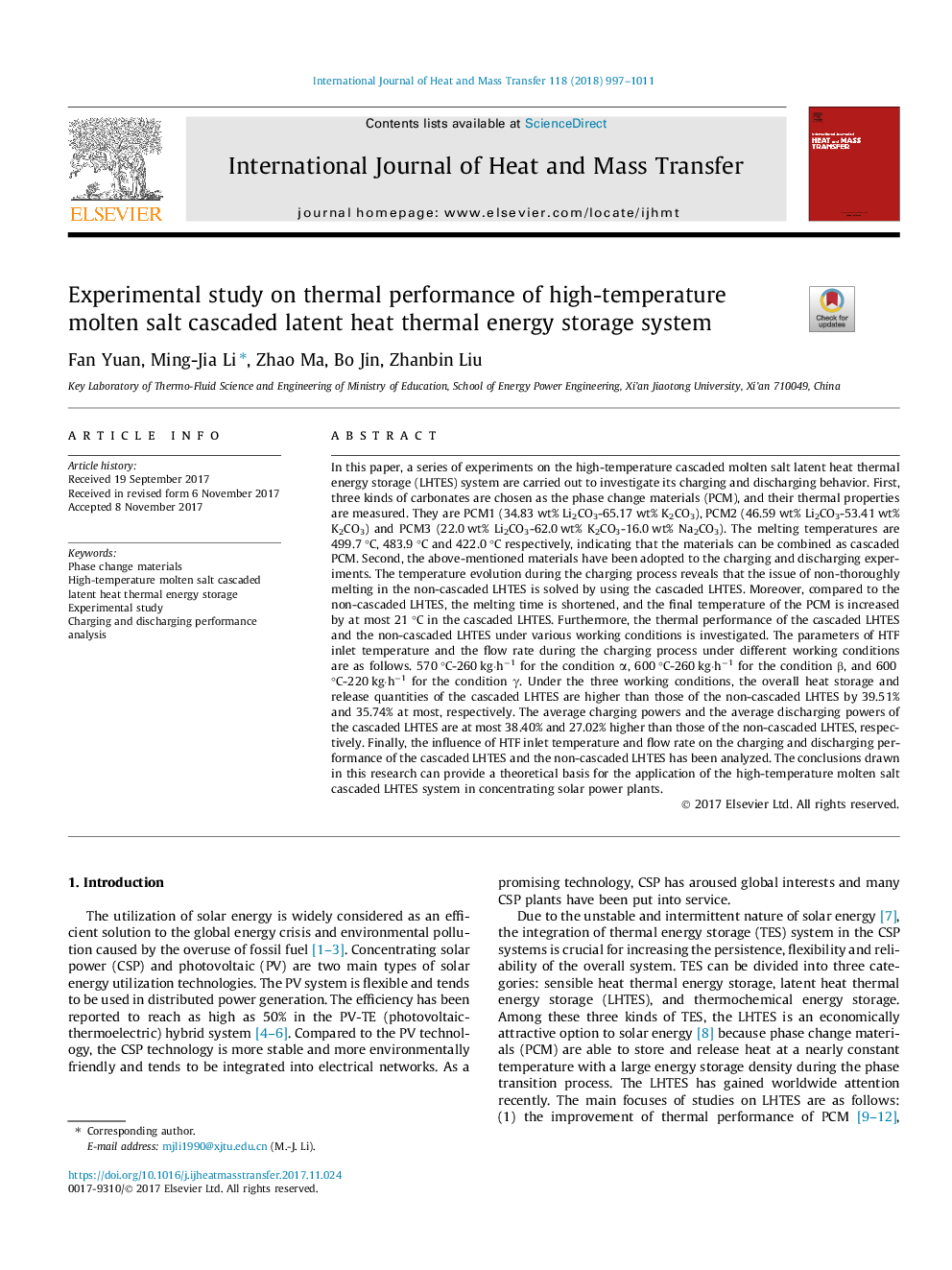| کد مقاله | کد نشریه | سال انتشار | مقاله انگلیسی | نسخه تمام متن |
|---|---|---|---|---|
| 7054817 | 1458022 | 2018 | 15 صفحه PDF | دانلود رایگان |
عنوان انگلیسی مقاله ISI
Experimental study on thermal performance of high-temperature molten salt cascaded latent heat thermal energy storage system
ترجمه فارسی عنوان
بررسی تجربی بر روی عملکرد حرارتی سیستم ذخیره سازی انرژی حرارتی پنهان شده در آب نمک مذاب درجه حرارت بالا
دانلود مقاله + سفارش ترجمه
دانلود مقاله ISI انگلیسی
رایگان برای ایرانیان
کلمات کلیدی
مواد تغییر فاز، ذخیره سازی حرارتی حرارتی پائین حرارت بالا، مطالعه تجربی، تجزیه و تحلیل عملکرد شارژ و تخلیه،
موضوعات مرتبط
مهندسی و علوم پایه
مهندسی شیمی
جریان سیال و فرایندهای انتقال
چکیده انگلیسی
In this paper, a series of experiments on the high-temperature cascaded molten salt latent heat thermal energy storage (LHTES) system are carried out to investigate its charging and discharging behavior. First, three kinds of carbonates are chosen as the phase change materials (PCM), and their thermal properties are measured. They are PCM1 (34.83â¯wt% Li2CO3-65.17â¯wt% K2CO3), PCM2 (46.59â¯wt% Li2CO3-53.41â¯wt% K2CO3) and PCM3 (22.0â¯wt% Li2CO3-62.0â¯wt% K2CO3-16.0â¯wt% Na2CO3). The melting temperatures are 499.7â¯Â°C, 483.9â¯Â°C and 422.0â¯Â°C respectively, indicating that the materials can be combined as cascaded PCM. Second, the above-mentioned materials have been adopted to the charging and discharging experiments. The temperature evolution during the charging process reveals that the issue of non-thoroughly melting in the non-cascaded LHTES is solved by using the cascaded LHTES. Moreover, compared to the non-cascaded LHTES, the melting time is shortened, and the final temperature of the PCM is increased by at most 21â¯Â°C in the cascaded LHTES. Furthermore, the thermal performance of the cascaded LHTES and the non-cascaded LHTES under various working conditions is investigated. The parameters of HTF inlet temperature and the flow rate during the charging process under different working conditions are as follows. 570â¯Â°C-260â¯kg·hâ1 for the condition α, 600â¯Â°C-260â¯kg·hâ1 for the condition β, and 600â¯Â°C-220â¯kg·hâ1 for the condition γ. Under the three working conditions, the overall heat storage and release quantities of the cascaded LHTES are higher than those of the non-cascaded LHTES by 39.51% and 35.74% at most, respectively. The average charging powers and the average discharging powers of the cascaded LHTES are at most 38.40% and 27.02% higher than those of the non-cascaded LHTES, respectively. Finally, the influence of HTF inlet temperature and flow rate on the charging and discharging performance of the cascaded LHTES and the non-cascaded LHTES has been analyzed. The conclusions drawn in this research can provide a theoretical basis for the application of the high-temperature molten salt cascaded LHTES system in concentrating solar power plants.
ناشر
Database: Elsevier - ScienceDirect (ساینس دایرکت)
Journal: International Journal of Heat and Mass Transfer - Volume 118, March 2018, Pages 997-1011
Journal: International Journal of Heat and Mass Transfer - Volume 118, March 2018, Pages 997-1011
نویسندگان
Fan Yuan, Ming-Jia Li, Zhao Ma, Bo Jin, Zhanbin Liu,
